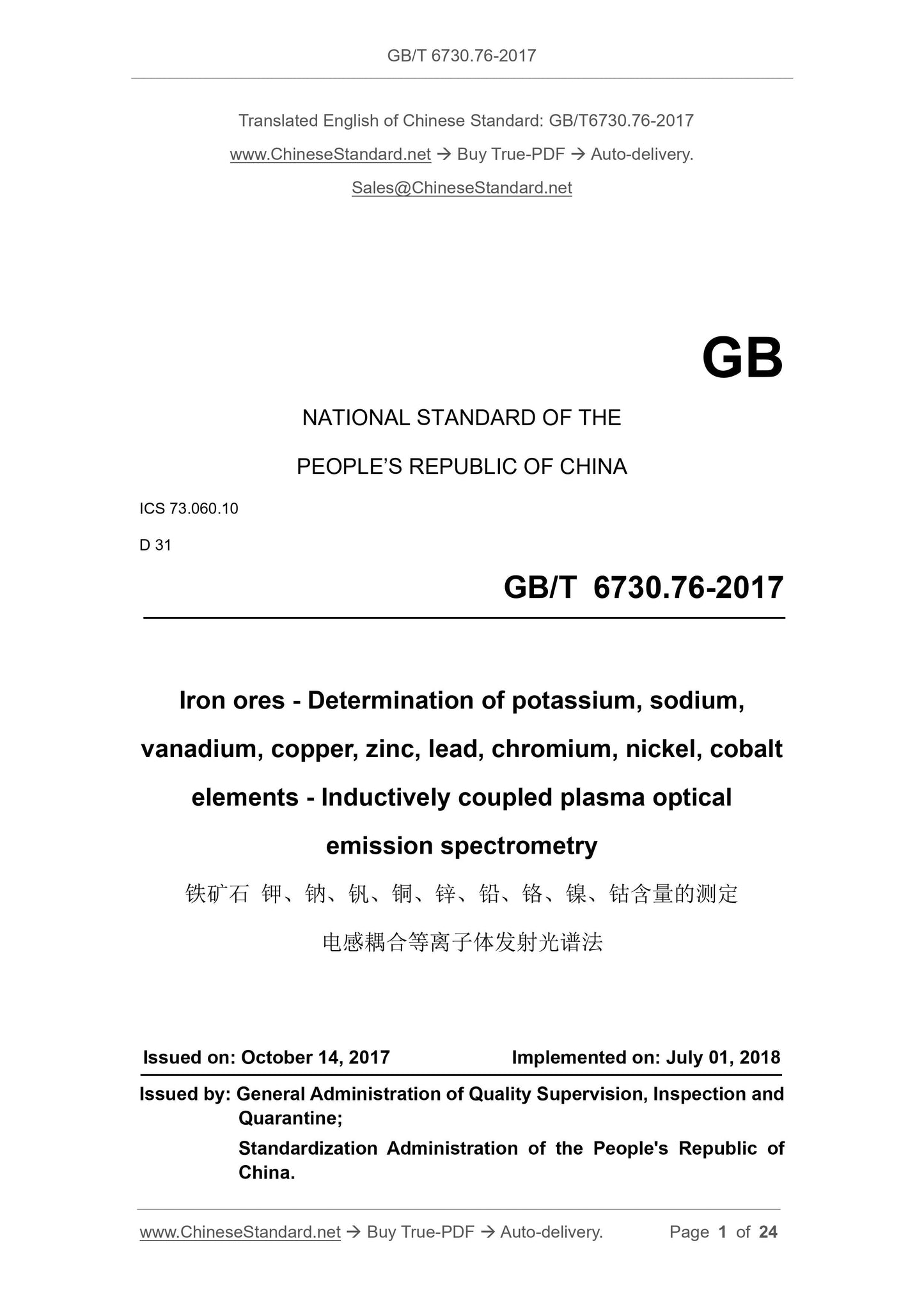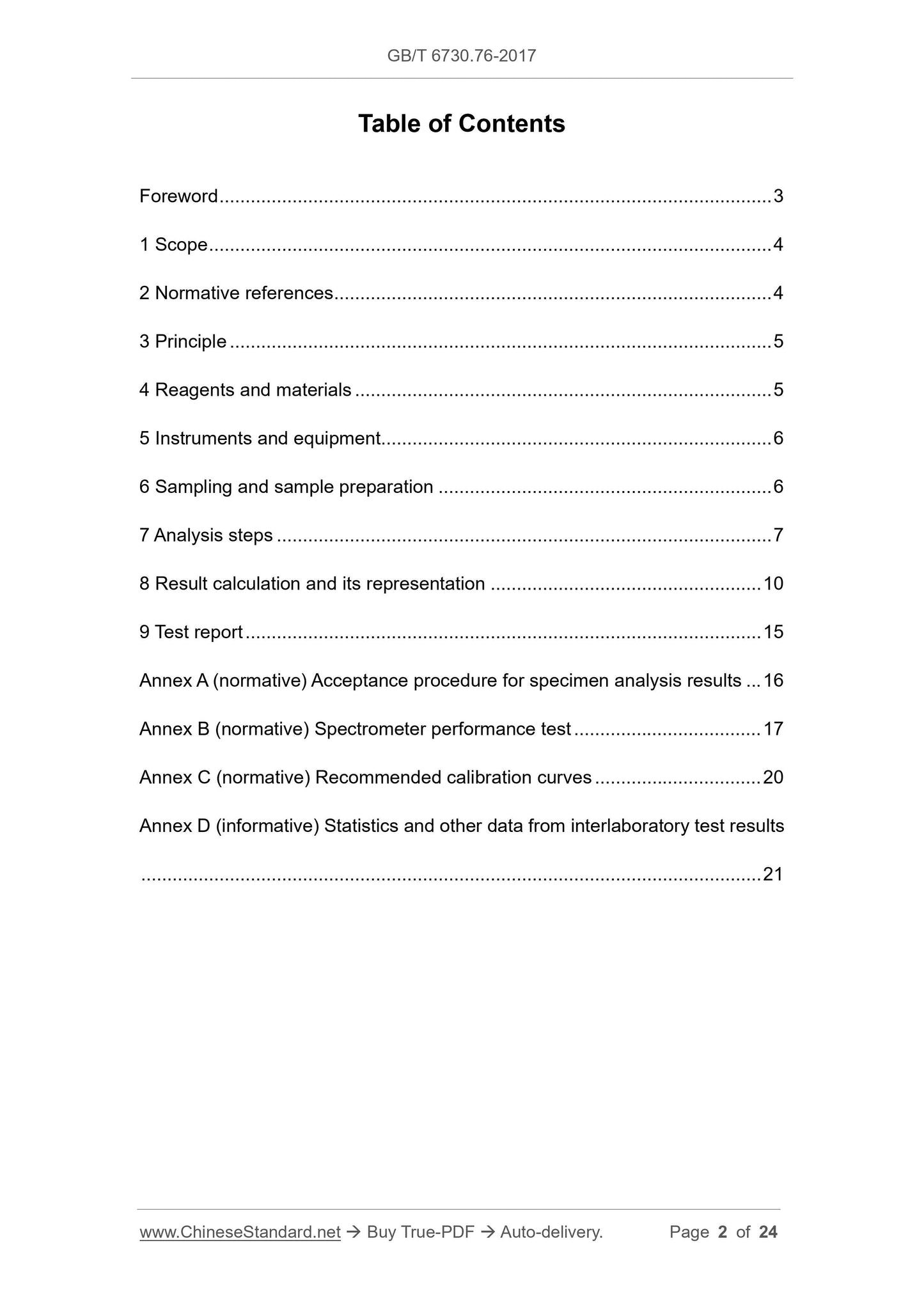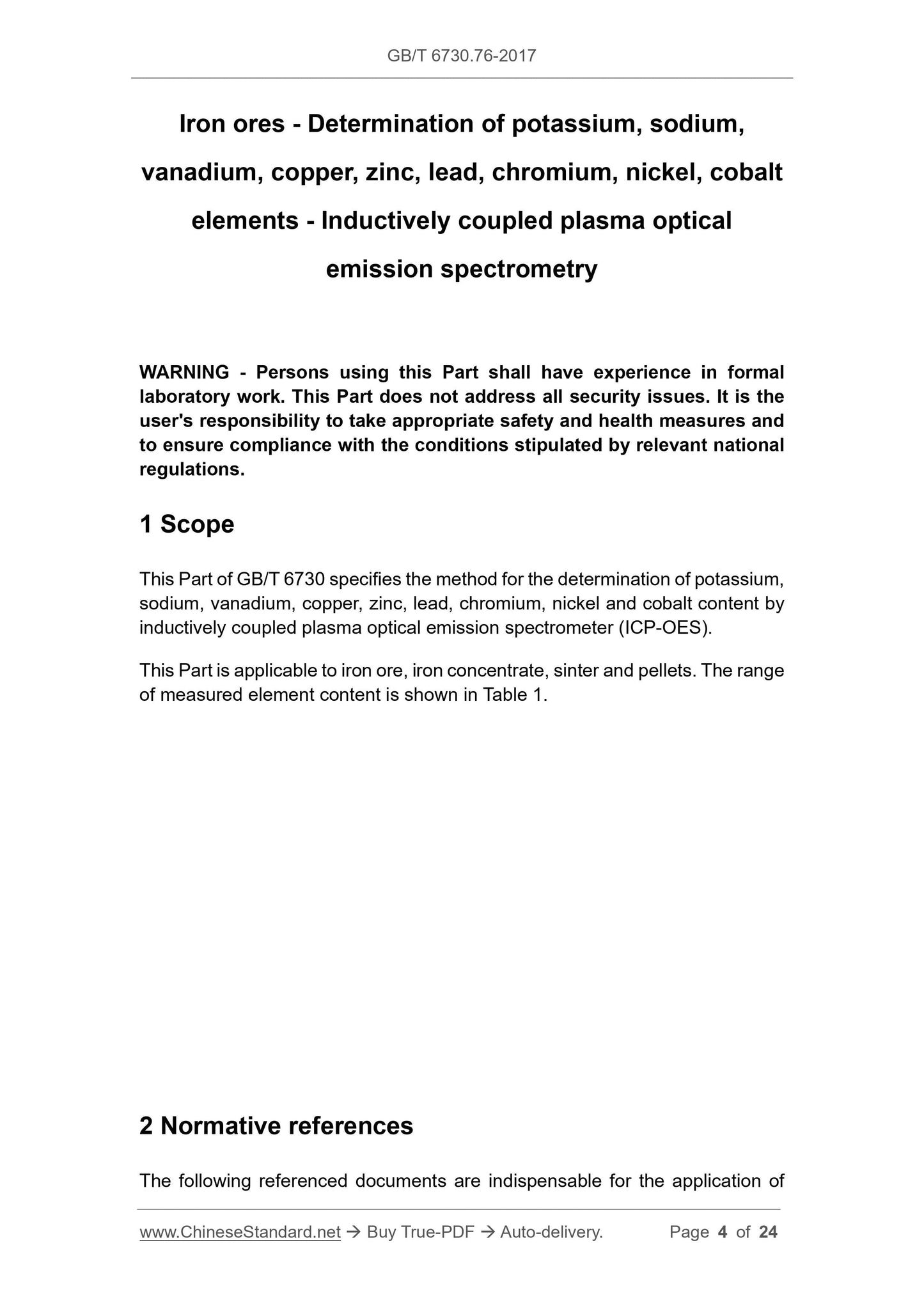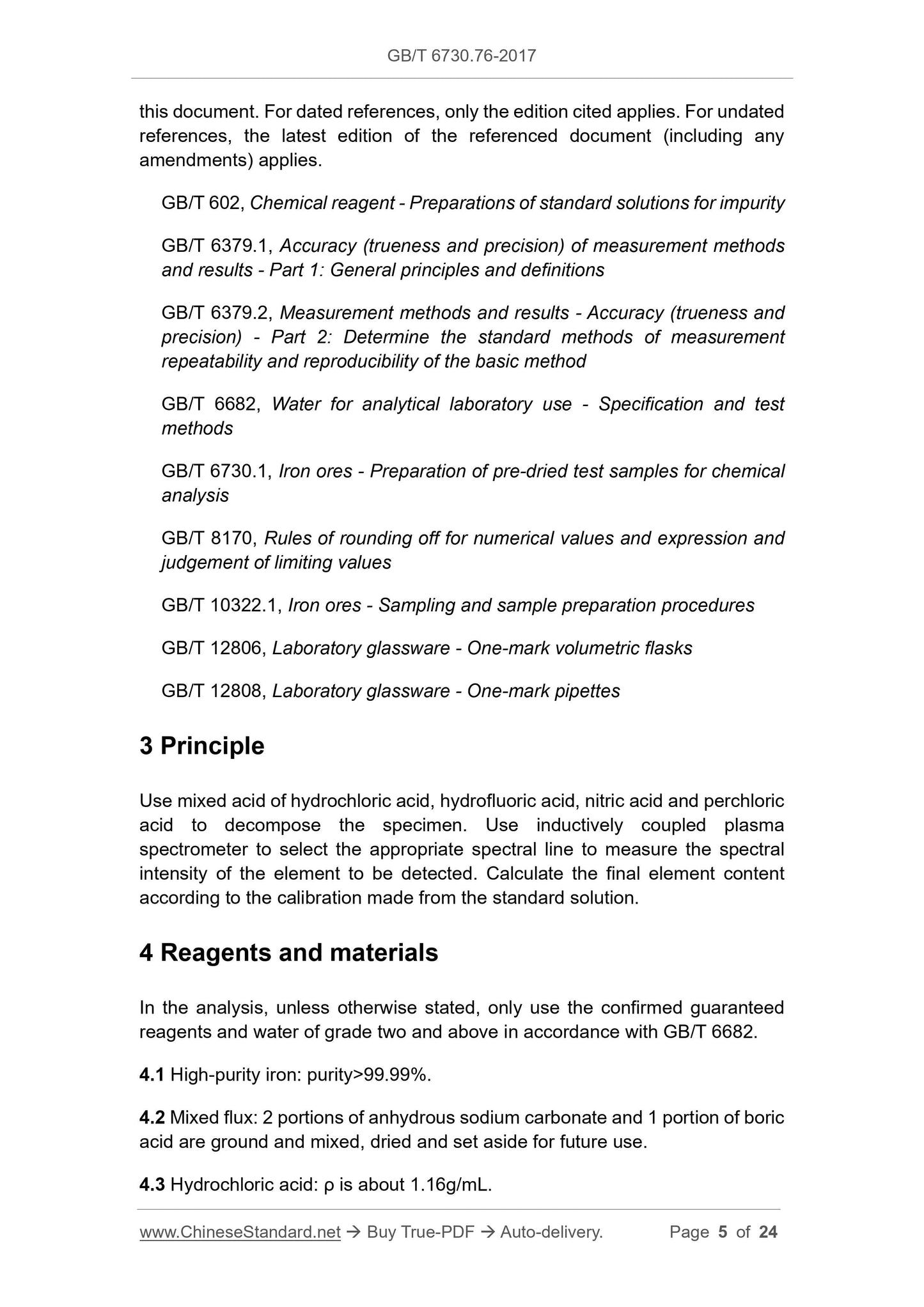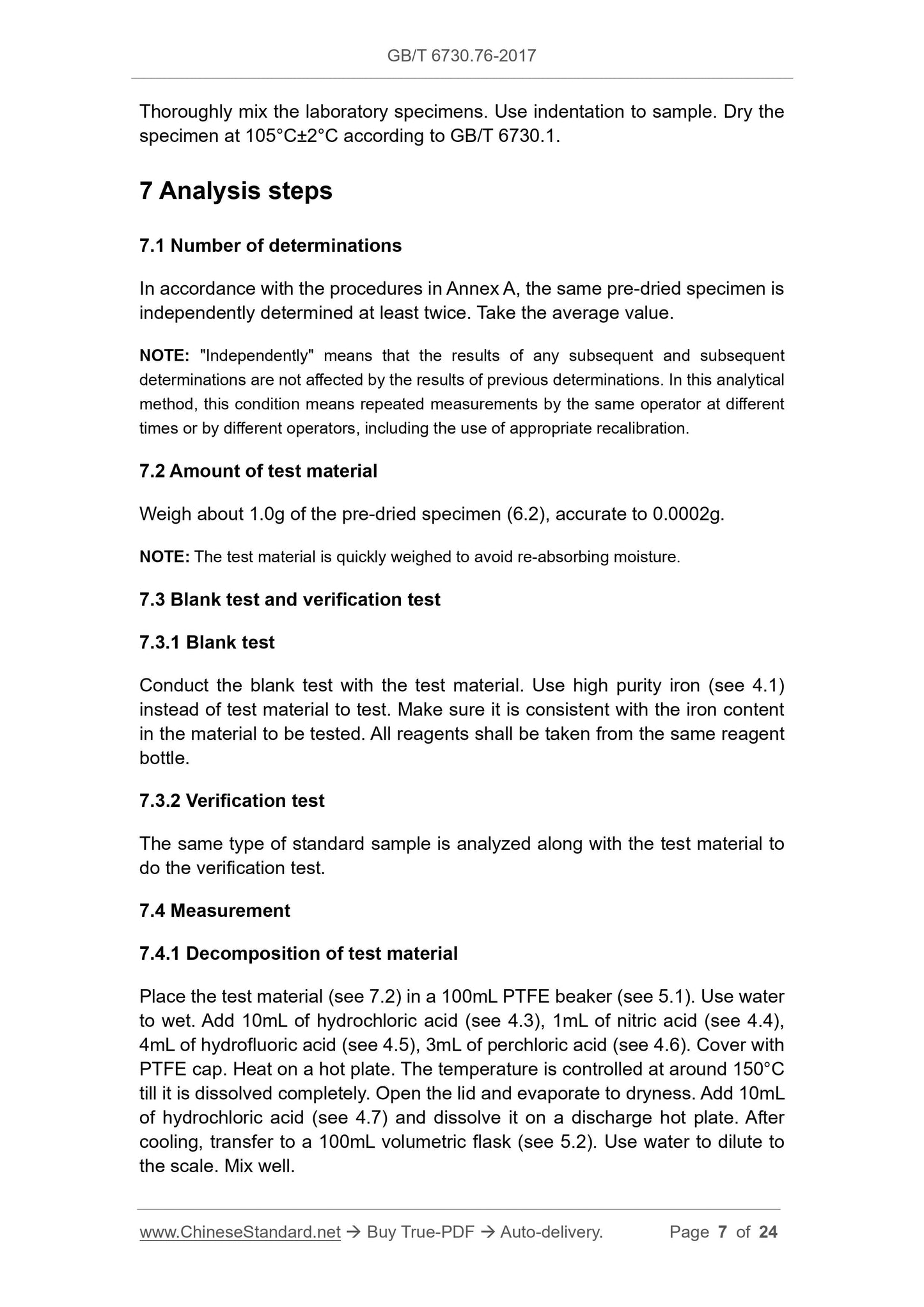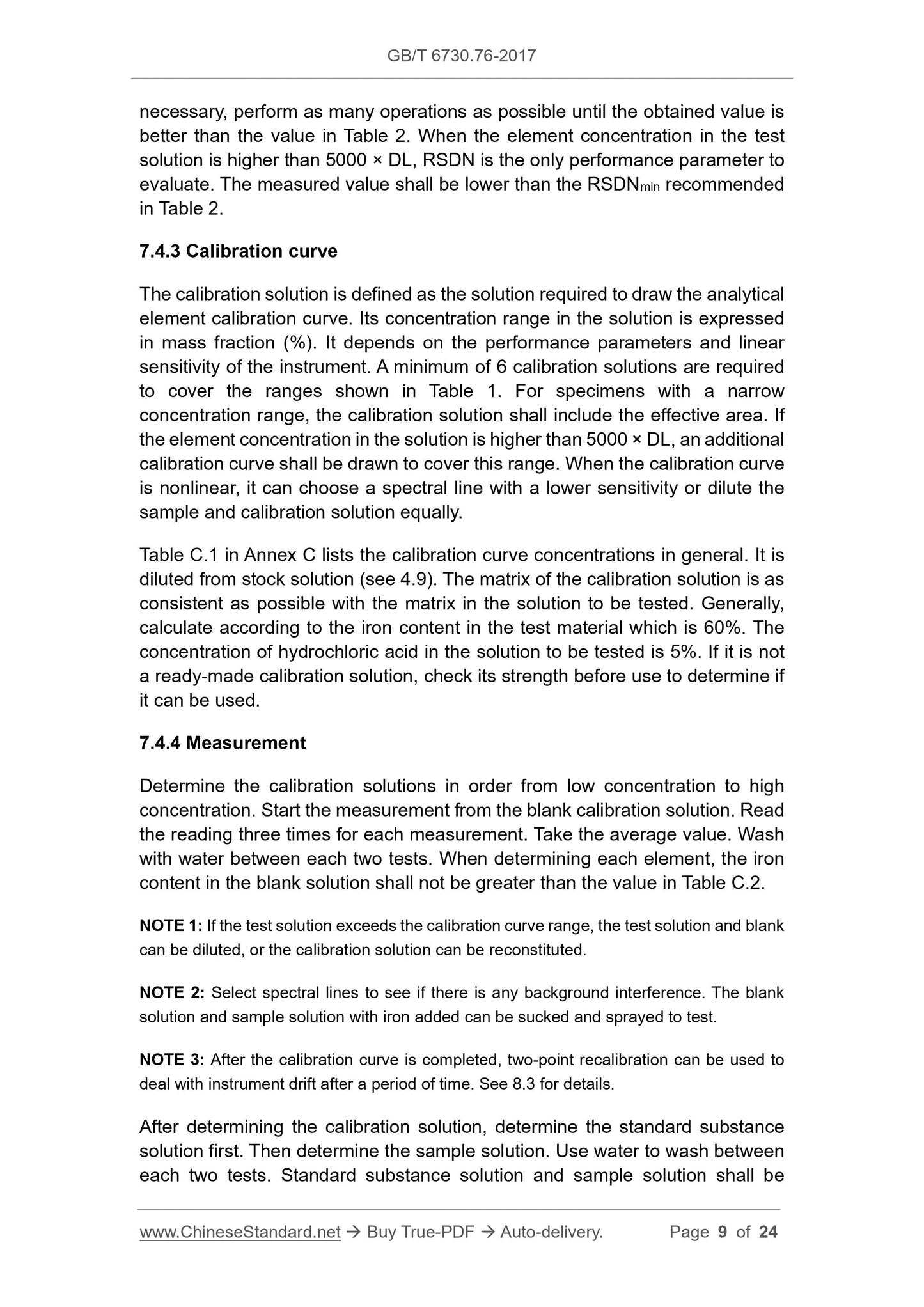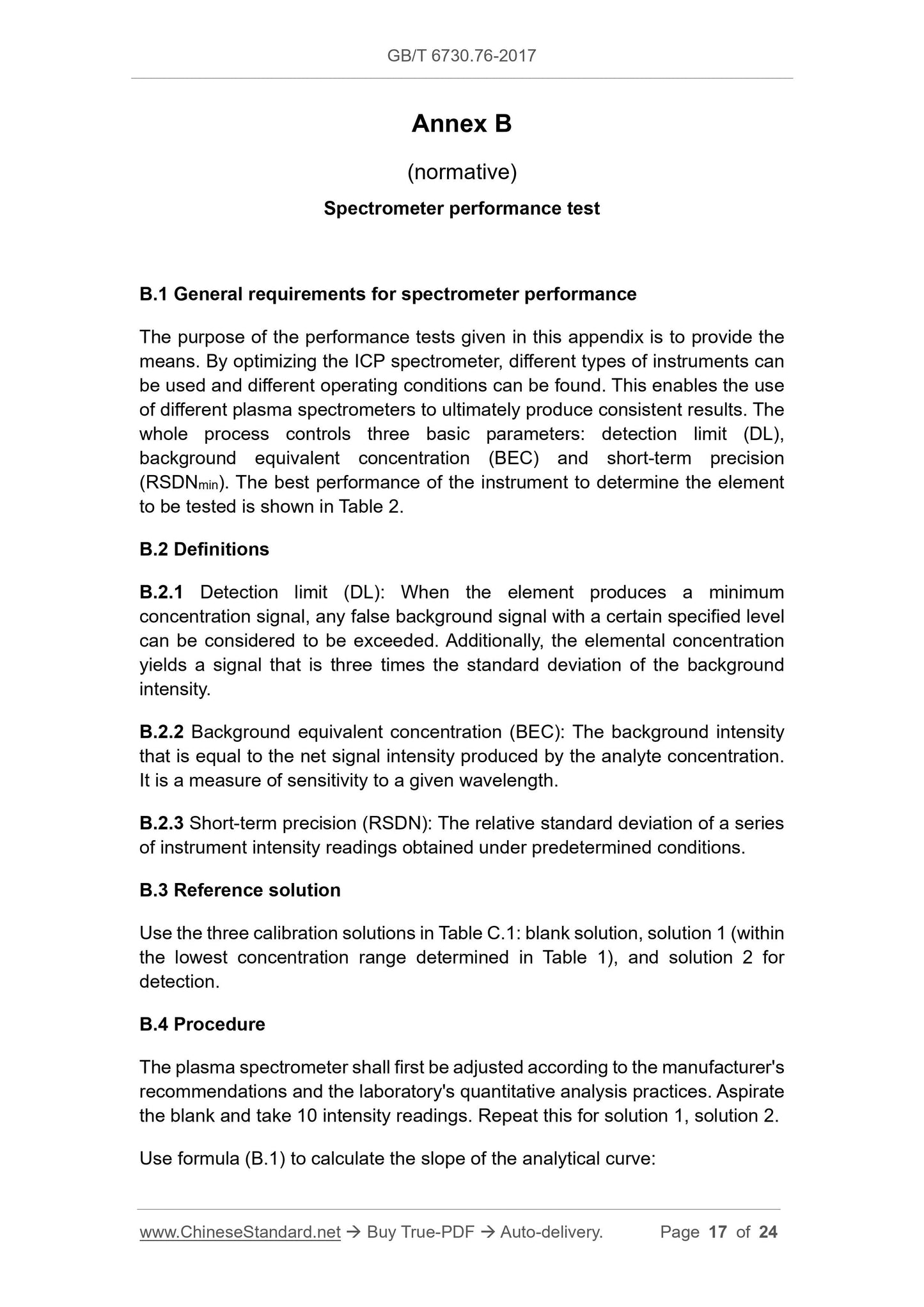1
/
of
7
www.ChineseStandard.us -- Field Test Asia Pte. Ltd.
GB/T 6730.76-2017 English PDF (GB/T6730.76-2017)
GB/T 6730.76-2017 English PDF (GB/T6730.76-2017)
Regular price
$260.00
Regular price
Sale price
$260.00
Unit price
/
per
Shipping calculated at checkout.
Couldn't load pickup availability
GB/T 6730.76-2017: Iron ores - Determination of potassium, sodium, vanadium, copper, zinc, lead, chromium, nickel, cobalt elements - Inductively coupled plasma optical emission spectrometry
Delivery: 9 seconds. Download (& Email) true-PDF + Invoice.
Get Quotation: Click GB/T 6730.76-2017 (Self-service in 1-minute)
Historical versions (Master-website): GB/T 6730.76-2017
Preview True-PDF (Reload/Scroll-down if blank)
GB/T 6730.76-2017
GB
NATIONAL STANDARD OF THE
PEOPLE’S REPUBLIC OF CHINA
ICS 73.060.10
D 31
Iron ores - Determination of potassium, sodium,
vanadium, copper, zinc, lead, chromium, nickel, cobalt
elements - Inductively coupled plasma optical
emission spectrometry
ISSUED ON: OCTOBER 14, 2017
IMPLEMENTED ON: JULY 01, 2018
Issued by: General Administration of Quality Supervision, Inspection and
Quarantine;
Standardization Administration of the People's Republic of
China.
Table of Contents
Foreword ... 3
1 Scope ... 4
2 Normative references ... 4
3 Principle ... 5
4 Reagents and materials ... 5
5 Instruments and equipment... 6
6 Sampling and sample preparation ... 6
7 Analysis steps ... 7
8 Result calculation and its representation ... 10
9 Test report ... 15
Annex A (normative) Acceptance procedure for specimen analysis results ... 16
Annex B (normative) Spectrometer performance test ... 17
Annex C (normative) Recommended calibration curves ... 20
Annex D (informative) Statistics and other data from interlaboratory test results
... 21
Iron ores - Determination of potassium, sodium,
vanadium, copper, zinc, lead, chromium, nickel, cobalt
elements - Inductively coupled plasma optical
emission spectrometry
WARNING - Persons using this Part shall have experience in formal
laboratory work. This Part does not address all security issues. It is the
user's responsibility to take appropriate safety and health measures and
to ensure compliance with the conditions stipulated by relevant national
regulations.
1 Scope
This Part of GB/T 6730 specifies the method for the determination of potassium,
sodium, vanadium, copper, zinc, lead, chromium, nickel and cobalt content by
inductively coupled plasma optical emission spectrometer (ICP-OES).
This Part is applicable to iron ore, iron concentrate, sinter and pellets. The range
of measured element content is shown in Table 1.
2 Normative references
The following referenced documents are indispensable for the application of
this document. For dated references, only the edition cited applies. For undated
references, the latest edition of the referenced document (including any
amendments) applies.
GB/T 602, Chemical reagent - Preparations of standard solutions for impurity
GB/T 6379.1, Accuracy (trueness and precision) of measurement methods
and results - Part 1: General principles and definitions
GB/T 6379.2, Measurement methods and results - Accuracy (trueness and
precision) - Part 2: Determine the standard methods of measurement
repeatability and reproducibility of the basic method
GB/T 6682, Water for analytical laboratory use - Specification and test
methods
GB/T 6730.1, Iron ores - Preparation of pre-dried test samples for chemical
analysis
GB/T 8170, Rules of rounding off for numerical values and expression and
judgement of limiting values
GB/T 10322.1, Iron ores - Sampling and sample preparation procedures
GB/T 12806, Laboratory glassware - One-mark volumetric flasks
GB/T 12808, Laboratory glassware - One-mark pipettes
3 Principle
Use mixed acid of hydrochloric acid, hydrofluoric acid, nitric acid and perchloric
acid to decompose the specimen. Use inductively coupled plasma
spectrometer to select the appropriate spectral line to measure the spectral
intensity of the element to be detected. Calculate the final element content
according to the calibration made from the standard solution.
4 Reagents and materials
In the analysis, unless otherwise stated, only use the confirmed guaranteed
reagents and water of grade two and above in accordance with GB/T 6682.
4.1 High-purity iron: purity>99.99%.
4.2 Mixed flux: 2 portions of anhydrous sodium carbonate and 1 portion of boric
acid are ground and mixed, dried and set aside for future use.
4.3 Hydrochloric acid: ρ is about 1.16g/mL.
Thoroughly mix the laboratory specimens. Use indentation to sample. Dry the
specimen at 105°C±2°C according to GB/T 6730.1.
7 Analysis steps
7.1 Number of determinations
In accordance with the procedures in Annex A, the same pre-dried specimen is
independently determined at least twice. Take the average value.
NOTE: "Independently" means that the results of any subsequent and subsequent
determinations are not affected by the results of previous determinations. In this analytical
method, this condition means repeated measurements by the same operator at different
times or by different operators, including the use of appropriate recalibration.
7.2 Amount of test material
Weigh about 1.0g of the pre-dried specimen (6.2), accurate to 0.0002g.
NOTE: The test material is quickly weighed to avoid re-absorbing moisture.
7.3 Blank test and verification test
7.3.1 Blank test
Conduct the blank test with the test material. Use high purity iron (see 4.1)
instead of test material to test. Make sure it is consistent with the iron content
in the material to be tested. All reagents shall be taken from the same reagent
bottle.
7.3.2 Verification test
The same type of standard sample is analyzed along with the test material to
do the verification test.
7.4 Measurement
7.4.1 Decomposition of test material
Place the test material (see 7.2) in a 100mL PTFE beaker (see 5.1). Use water
to wet. Add 10mL of hydrochloric acid (see 4.3), 1mL of nitric acid (see 4.4),
4mL of hydrofluoric acid (see 4.5), 3mL of perchloric acid (see 4.6). Cover with
PTFE cap. Heat on a hot plate. The temperature is controlled at around 150°C
till it is dissolved completely. Open the lid and evaporate to dryness. Add 10mL
of hydrochloric acid (see 4.7) and dissolve it on a discharge hot plate. After
cooling, transfer to a 100mL volumetric flask (see 5.2). Use water to dilute to
the scale. Mix well.
necessary, perform as many operations as possible until the obtained value is
better than the value in Table 2. When the element concentration in the test
solution is higher than 5000 × DL, RSDN is the only performance parameter to
evaluate. The measured value shall be lower than the RSDNmin recommended
in Table 2.
7.4.3 Calibration curve
The calibration solution is defined as the solution required to draw the analytical
element calibration curve. Its concentration range in the solution is expressed
in mass fraction (%). It depends on the performance parameters and linear
sensitivity of the instrument. A minimum of 6 calibration solutions are required
to cover the ranges shown in Table 1. For specimens with a narrow
concentration range, the calibration solution shall include the effective area. If
the element concentration in the solution is higher than 5000 × DL, an additional
calibration curve shall be drawn to cover this range. When the calibration curve
is nonlinear, it can choose a spectral line with a lower sensitivity or dilute the
sample and calibration solution equally.
Table C.1 in Annex C lists the calibration curve concentrations in general. It is
diluted from stock solution (see 4.9). The matrix of the calibration solution is as
consistent as possible with the matrix in the solution to be tested. Generally,
calculate according to the iron content in the test material which is 60%. The
concentration of hydrochloric acid in the solution to be tested is 5%. If it is not
a ready-made calibration solution, check its strength before use to determine if
it can be used.
7.4.4 Measurement
Determine the calibration solutions in order from low concentration to high
concentration. Start the measurement from the blank calibration solution. Read
the reading three times for each measurement. Take the average value. Wash
with water between each two tests. When determining each element, the iron
content in the blank solution shall not be greater than the value in Table C.2.
NOTE 1: If the test solution exceeds the calibration curve range, the test solution and blank
can be diluted, or the calibration solution can be reconstituted.
NOTE 2: Select spectral lines to see if there is any background interference. The blank
solution and sample solution with iron added can be sucked and sprayed to test.
NOTE 3: After the calibration curve is completed, two-point recalibration can be used to
deal with instrument drift after a period of time. See 8.3 for details.
After determining the calibration solution, determine the standard substance
solution first. Then determine the sample solution. Use water to wash between
each two tests. Standard substance solution and sample solution shall be
Annex B
(normative)
Spectrometer performance test
B.1 General requirements for spectrometer performance
The purpose of the performance tests given in this appendix is to provide the
means. By optimizing the ICP spectrometer, different types of instruments can
be used and different operating conditions can be found. This enables the use
of different plasma spectrometers to ultimately produce consistent results. The
whole process controls three basic parameters: detection limit (DL),
background equivalent concentration (BEC) and short-term precision
(RSDNmin). The best performance of the instrument to determine the element
to be tested is shown in Table 2.
B.2 Definitions
B.2.1 Detection limit (DL): When the element produces a minimum
concentration signal, any false background signal with a certain specified level
can be considered to be exceeded. Additionally, the elemental concentration
yields a signal that is three times the standard deviation of the background
intensity.
B.2.2 Background equivalent concentration (BEC): The background intensity
that is equal to the net signal intensity produced by the analyte concentration.
It is a measure of sensitivity to a given wavelength.
B.2.3 Short-term precision (RSDN): The relative standard deviation of a series
of instrument intensity readings obtained under predetermined conditions.
B.3 Reference solution
Use the three calibration solutions in Table C.1: blank solution, solution 1 (within
the lowest concentration range determined in Table 1), and solution 2 for
detection.
B.4 Procedure
The plasma spectrometer shall first be adjusted according to the manufacturer's
recommendations and the laboratory's quantitative analysis practices. Aspirate
the blank and take 10 intensity readings. Repeat this for solution 1, solution 2.
Use formula (B.1) to calculate the slope of the analytical curve:
GB/T 6730.76-2017
GB
NATIONAL STANDARD OF THE
PEOPLE’S REPUBLIC OF CHINA
ICS 73.060.10
D 31
Iron ores - Determination of potassium, sodium,
vanadium, copper, zinc, lead, chromium, nickel, cobalt
elements - Inductively coupled plasma optical
emission spectrometry
ISSUED ON: OCTOBER 14, 2017
IMPLEMENTED ON: JULY 01, 2018
Issued by: General Administration of Quality Supervision, Inspection and
Quarantine;
Standardization Administration of the People's Republic of
China.
Table of Contents
Foreword ... 3
1 Scope ... 4
2 Normative references ... 4
3 Principle ... 5
4 Reagents and materials ... 5
5 Instruments and equipment... 6
6 Sampling and sample preparation ... 6
7 Analysis steps ... 7
8 Result calculation and its representation ... 10
9 Test report ... 15
Annex A (normative) Acceptance procedure for specimen analysis results ... 16
Annex B (normative) Spectrometer performance test ... 17
Annex C (normative) Recommended calibration curves ... 20
Annex D (informative) Statistics and other data from interlaboratory test results
... 21
Iron ores - Determination of potassium, sodium,
vanadium, copper, zinc, lead, chromium, nickel, cobalt
elements - Inductively coupled plasma optical
emission spectrometry
WARNING - Persons using this Part shall have experience in formal
laboratory work. This Part does not address all security issues. It is the
user's responsibility to take appropriate safety and health measures and
to ensure compliance with the conditions stipulated by relevant national
regulations.
1 Scope
This Part of GB/T 6730 specifies the method for the determination of potassium,
sodium, vanadium, copper, zinc, lead, chromium, nickel and cobalt content by
inductively coupled plasma optical emission spectrometer (ICP-OES).
This Part is applicable to iron ore, iron concentrate, sinter and pellets. The range
of measured element content is shown in Table 1.
2 Normative references
The following referenced documents are indispensable for the application of
this document. For dated references, only the edition cited applies. For undated
references, the latest edition of the referenced document (including any
amendments) applies.
GB/T 602, Chemical reagent - Preparations of standard solutions for impurity
GB/T 6379.1, Accuracy (trueness and precision) of measurement methods
and results - Part 1: General principles and definitions
GB/T 6379.2, Measurement methods and results - Accuracy (trueness and
precision) - Part 2: Determine the standard methods of measurement
repeatability and reproducibility of the basic method
GB/T 6682, Water for analytical laboratory use - Specification and test
methods
GB/T 6730.1, Iron ores - Preparation of pre-dried test samples for chemical
analysis
GB/T 8170, Rules of rounding off for numerical values and expression and
judgement of limiting values
GB/T 10322.1, Iron ores - Sampling and sample preparation procedures
GB/T 12806, Laboratory glassware - One-mark volumetric flasks
GB/T 12808, Laboratory glassware - One-mark pipettes
3 Principle
Use mixed acid of hydrochloric acid, hydrofluoric acid, nitric acid and perchloric
acid to decompose the specimen. Use inductively coupled plasma
spectrometer to select the appropriate spectral line to measure the spectral
intensity of the element to be detected. Calculate the final element content
according to the calibration made from the standard solution.
4 Reagents and materials
In the analysis, unless otherwise stated, o...
Delivery: 9 seconds. Download (& Email) true-PDF + Invoice.
Get Quotation: Click GB/T 6730.76-2017 (Self-service in 1-minute)
Historical versions (Master-website): GB/T 6730.76-2017
Preview True-PDF (Reload/Scroll-down if blank)
GB/T 6730.76-2017
GB
NATIONAL STANDARD OF THE
PEOPLE’S REPUBLIC OF CHINA
ICS 73.060.10
D 31
Iron ores - Determination of potassium, sodium,
vanadium, copper, zinc, lead, chromium, nickel, cobalt
elements - Inductively coupled plasma optical
emission spectrometry
ISSUED ON: OCTOBER 14, 2017
IMPLEMENTED ON: JULY 01, 2018
Issued by: General Administration of Quality Supervision, Inspection and
Quarantine;
Standardization Administration of the People's Republic of
China.
Table of Contents
Foreword ... 3
1 Scope ... 4
2 Normative references ... 4
3 Principle ... 5
4 Reagents and materials ... 5
5 Instruments and equipment... 6
6 Sampling and sample preparation ... 6
7 Analysis steps ... 7
8 Result calculation and its representation ... 10
9 Test report ... 15
Annex A (normative) Acceptance procedure for specimen analysis results ... 16
Annex B (normative) Spectrometer performance test ... 17
Annex C (normative) Recommended calibration curves ... 20
Annex D (informative) Statistics and other data from interlaboratory test results
... 21
Iron ores - Determination of potassium, sodium,
vanadium, copper, zinc, lead, chromium, nickel, cobalt
elements - Inductively coupled plasma optical
emission spectrometry
WARNING - Persons using this Part shall have experience in formal
laboratory work. This Part does not address all security issues. It is the
user's responsibility to take appropriate safety and health measures and
to ensure compliance with the conditions stipulated by relevant national
regulations.
1 Scope
This Part of GB/T 6730 specifies the method for the determination of potassium,
sodium, vanadium, copper, zinc, lead, chromium, nickel and cobalt content by
inductively coupled plasma optical emission spectrometer (ICP-OES).
This Part is applicable to iron ore, iron concentrate, sinter and pellets. The range
of measured element content is shown in Table 1.
2 Normative references
The following referenced documents are indispensable for the application of
this document. For dated references, only the edition cited applies. For undated
references, the latest edition of the referenced document (including any
amendments) applies.
GB/T 602, Chemical reagent - Preparations of standard solutions for impurity
GB/T 6379.1, Accuracy (trueness and precision) of measurement methods
and results - Part 1: General principles and definitions
GB/T 6379.2, Measurement methods and results - Accuracy (trueness and
precision) - Part 2: Determine the standard methods of measurement
repeatability and reproducibility of the basic method
GB/T 6682, Water for analytical laboratory use - Specification and test
methods
GB/T 6730.1, Iron ores - Preparation of pre-dried test samples for chemical
analysis
GB/T 8170, Rules of rounding off for numerical values and expression and
judgement of limiting values
GB/T 10322.1, Iron ores - Sampling and sample preparation procedures
GB/T 12806, Laboratory glassware - One-mark volumetric flasks
GB/T 12808, Laboratory glassware - One-mark pipettes
3 Principle
Use mixed acid of hydrochloric acid, hydrofluoric acid, nitric acid and perchloric
acid to decompose the specimen. Use inductively coupled plasma
spectrometer to select the appropriate spectral line to measure the spectral
intensity of the element to be detected. Calculate the final element content
according to the calibration made from the standard solution.
4 Reagents and materials
In the analysis, unless otherwise stated, only use the confirmed guaranteed
reagents and water of grade two and above in accordance with GB/T 6682.
4.1 High-purity iron: purity>99.99%.
4.2 Mixed flux: 2 portions of anhydrous sodium carbonate and 1 portion of boric
acid are ground and mixed, dried and set aside for future use.
4.3 Hydrochloric acid: ρ is about 1.16g/mL.
Thoroughly mix the laboratory specimens. Use indentation to sample. Dry the
specimen at 105°C±2°C according to GB/T 6730.1.
7 Analysis steps
7.1 Number of determinations
In accordance with the procedures in Annex A, the same pre-dried specimen is
independently determined at least twice. Take the average value.
NOTE: "Independently" means that the results of any subsequent and subsequent
determinations are not affected by the results of previous determinations. In this analytical
method, this condition means repeated measurements by the same operator at different
times or by different operators, including the use of appropriate recalibration.
7.2 Amount of test material
Weigh about 1.0g of the pre-dried specimen (6.2), accurate to 0.0002g.
NOTE: The test material is quickly weighed to avoid re-absorbing moisture.
7.3 Blank test and verification test
7.3.1 Blank test
Conduct the blank test with the test material. Use high purity iron (see 4.1)
instead of test material to test. Make sure it is consistent with the iron content
in the material to be tested. All reagents shall be taken from the same reagent
bottle.
7.3.2 Verification test
The same type of standard sample is analyzed along with the test material to
do the verification test.
7.4 Measurement
7.4.1 Decomposition of test material
Place the test material (see 7.2) in a 100mL PTFE beaker (see 5.1). Use water
to wet. Add 10mL of hydrochloric acid (see 4.3), 1mL of nitric acid (see 4.4),
4mL of hydrofluoric acid (see 4.5), 3mL of perchloric acid (see 4.6). Cover with
PTFE cap. Heat on a hot plate. The temperature is controlled at around 150°C
till it is dissolved completely. Open the lid and evaporate to dryness. Add 10mL
of hydrochloric acid (see 4.7) and dissolve it on a discharge hot plate. After
cooling, transfer to a 100mL volumetric flask (see 5.2). Use water to dilute to
the scale. Mix well.
necessary, perform as many operations as possible until the obtained value is
better than the value in Table 2. When the element concentration in the test
solution is higher than 5000 × DL, RSDN is the only performance parameter to
evaluate. The measured value shall be lower than the RSDNmin recommended
in Table 2.
7.4.3 Calibration curve
The calibration solution is defined as the solution required to draw the analytical
element calibration curve. Its concentration range in the solution is expressed
in mass fraction (%). It depends on the performance parameters and linear
sensitivity of the instrument. A minimum of 6 calibration solutions are required
to cover the ranges shown in Table 1. For specimens with a narrow
concentration range, the calibration solution shall include the effective area. If
the element concentration in the solution is higher than 5000 × DL, an additional
calibration curve shall be drawn to cover this range. When the calibration curve
is nonlinear, it can choose a spectral line with a lower sensitivity or dilute the
sample and calibration solution equally.
Table C.1 in Annex C lists the calibration curve concentrations in general. It is
diluted from stock solution (see 4.9). The matrix of the calibration solution is as
consistent as possible with the matrix in the solution to be tested. Generally,
calculate according to the iron content in the test material which is 60%. The
concentration of hydrochloric acid in the solution to be tested is 5%. If it is not
a ready-made calibration solution, check its strength before use to determine if
it can be used.
7.4.4 Measurement
Determine the calibration solutions in order from low concentration to high
concentration. Start the measurement from the blank calibration solution. Read
the reading three times for each measurement. Take the average value. Wash
with water between each two tests. When determining each element, the iron
content in the blank solution shall not be greater than the value in Table C.2.
NOTE 1: If the test solution exceeds the calibration curve range, the test solution and blank
can be diluted, or the calibration solution can be reconstituted.
NOTE 2: Select spectral lines to see if there is any background interference. The blank
solution and sample solution with iron added can be sucked and sprayed to test.
NOTE 3: After the calibration curve is completed, two-point recalibration can be used to
deal with instrument drift after a period of time. See 8.3 for details.
After determining the calibration solution, determine the standard substance
solution first. Then determine the sample solution. Use water to wash between
each two tests. Standard substance solution and sample solution shall be
Annex B
(normative)
Spectrometer performance test
B.1 General requirements for spectrometer performance
The purpose of the performance tests given in this appendix is to provide the
means. By optimizing the ICP spectrometer, different types of instruments can
be used and different operating conditions can be found. This enables the use
of different plasma spectrometers to ultimately produce consistent results. The
whole process controls three basic parameters: detection limit (DL),
background equivalent concentration (BEC) and short-term precision
(RSDNmin). The best performance of the instrument to determine the element
to be tested is shown in Table 2.
B.2 Definitions
B.2.1 Detection limit (DL): When the element produces a minimum
concentration signal, any false background signal with a certain specified level
can be considered to be exceeded. Additionally, the elemental concentration
yields a signal that is three times the standard deviation of the background
intensity.
B.2.2 Background equivalent concentration (BEC): The background intensity
that is equal to the net signal intensity produced by the analyte concentration.
It is a measure of sensitivity to a given wavelength.
B.2.3 Short-term precision (RSDN): The relative standard deviation of a series
of instrument intensity readings obtained under predetermined conditions.
B.3 Reference solution
Use the three calibration solutions in Table C.1: blank solution, solution 1 (within
the lowest concentration range determined in Table 1), and solution 2 for
detection.
B.4 Procedure
The plasma spectrometer shall first be adjusted according to the manufacturer's
recommendations and the laboratory's quantitative analysis practices. Aspirate
the blank and take 10 intensity readings. Repeat this for solution 1, solution 2.
Use formula (B.1) to calculate the slope of the analytical curve:
GB/T 6730.76-2017
GB
NATIONAL STANDARD OF THE
PEOPLE’S REPUBLIC OF CHINA
ICS 73.060.10
D 31
Iron ores - Determination of potassium, sodium,
vanadium, copper, zinc, lead, chromium, nickel, cobalt
elements - Inductively coupled plasma optical
emission spectrometry
ISSUED ON: OCTOBER 14, 2017
IMPLEMENTED ON: JULY 01, 2018
Issued by: General Administration of Quality Supervision, Inspection and
Quarantine;
Standardization Administration of the People's Republic of
China.
Table of Contents
Foreword ... 3
1 Scope ... 4
2 Normative references ... 4
3 Principle ... 5
4 Reagents and materials ... 5
5 Instruments and equipment... 6
6 Sampling and sample preparation ... 6
7 Analysis steps ... 7
8 Result calculation and its representation ... 10
9 Test report ... 15
Annex A (normative) Acceptance procedure for specimen analysis results ... 16
Annex B (normative) Spectrometer performance test ... 17
Annex C (normative) Recommended calibration curves ... 20
Annex D (informative) Statistics and other data from interlaboratory test results
... 21
Iron ores - Determination of potassium, sodium,
vanadium, copper, zinc, lead, chromium, nickel, cobalt
elements - Inductively coupled plasma optical
emission spectrometry
WARNING - Persons using this Part shall have experience in formal
laboratory work. This Part does not address all security issues. It is the
user's responsibility to take appropriate safety and health measures and
to ensure compliance with the conditions stipulated by relevant national
regulations.
1 Scope
This Part of GB/T 6730 specifies the method for the determination of potassium,
sodium, vanadium, copper, zinc, lead, chromium, nickel and cobalt content by
inductively coupled plasma optical emission spectrometer (ICP-OES).
This Part is applicable to iron ore, iron concentrate, sinter and pellets. The range
of measured element content is shown in Table 1.
2 Normative references
The following referenced documents are indispensable for the application of
this document. For dated references, only the edition cited applies. For undated
references, the latest edition of the referenced document (including any
amendments) applies.
GB/T 602, Chemical reagent - Preparations of standard solutions for impurity
GB/T 6379.1, Accuracy (trueness and precision) of measurement methods
and results - Part 1: General principles and definitions
GB/T 6379.2, Measurement methods and results - Accuracy (trueness and
precision) - Part 2: Determine the standard methods of measurement
repeatability and reproducibility of the basic method
GB/T 6682, Water for analytical laboratory use - Specification and test
methods
GB/T 6730.1, Iron ores - Preparation of pre-dried test samples for chemical
analysis
GB/T 8170, Rules of rounding off for numerical values and expression and
judgement of limiting values
GB/T 10322.1, Iron ores - Sampling and sample preparation procedures
GB/T 12806, Laboratory glassware - One-mark volumetric flasks
GB/T 12808, Laboratory glassware - One-mark pipettes
3 Principle
Use mixed acid of hydrochloric acid, hydrofluoric acid, nitric acid and perchloric
acid to decompose the specimen. Use inductively coupled plasma
spectrometer to select the appropriate spectral line to measure the spectral
intensity of the element to be detected. Calculate the final element content
according to the calibration made from the standard solution.
4 Reagents and materials
In the analysis, unless otherwise stated, o...
Share
